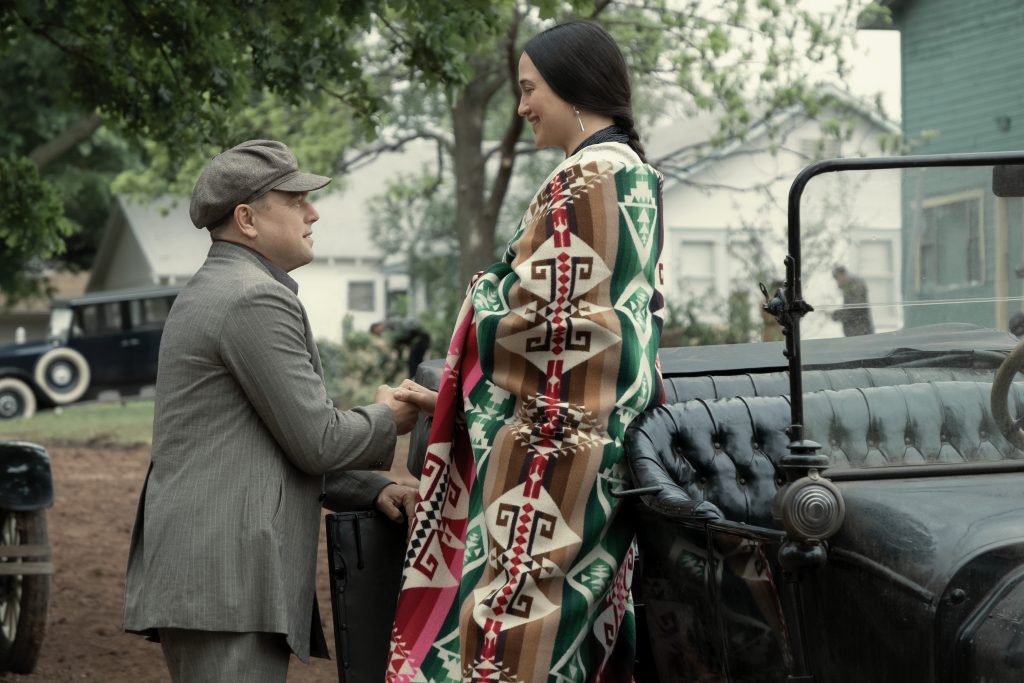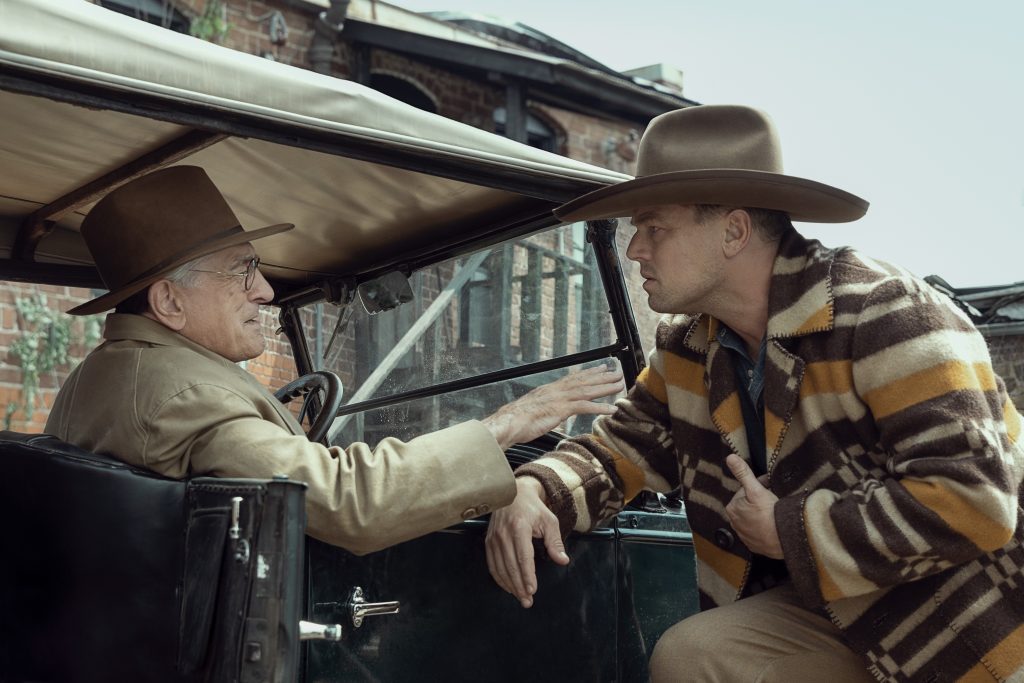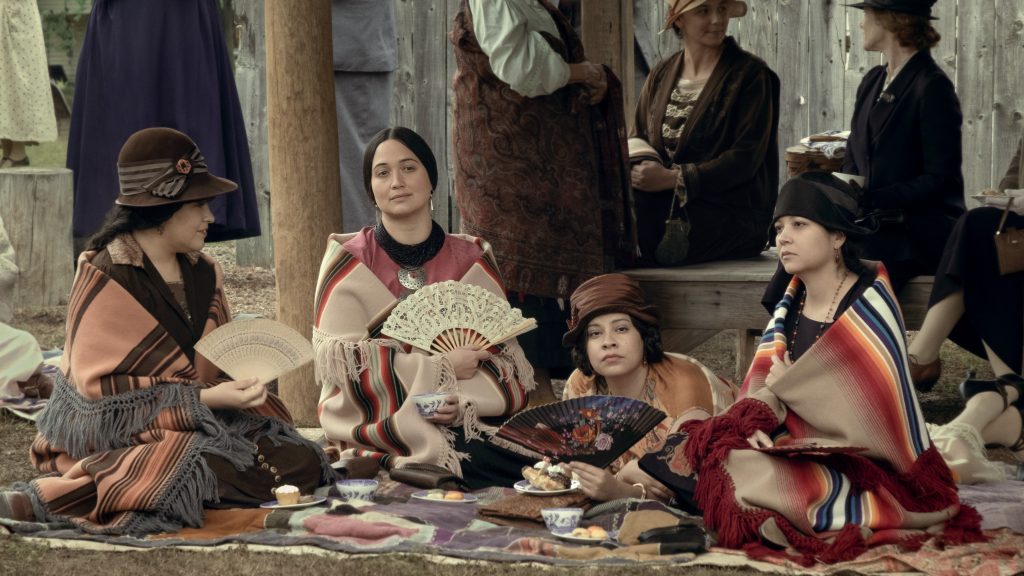‘Killers of the Flower Moon’: Gladstone Steals the Show in an All-Star Cast
- Like
- Digg
- Del
- Tumblr
- VKontakte
- Buffer
- Love This
- Odnoklassniki
- Meneame
- Blogger
- Amazon
- Yahoo Mail
- Gmail
- AOL
- Newsvine
- HackerNews
- Evernote
- MySpace
- Mail.ru
- Viadeo
- Line
- Comments
- Yummly
- SMS
- Viber
- Telegram
- Subscribe
- Skype
- Facebook Messenger
- Kakao
- LiveJournal
- Yammer
- Edgar
- Fintel
- Mix
- Instapaper
- Copy Link

Ernest Burkhardt (Leonardo DiCaprio) escorts his newly betrothed fiancé, Mollie Kyle (Lily Gladstone), whose traditional Osage attire belies her inordinate wealth.
There’s a line early in Martin Scorsese’s majestic Killers of the Flower Moon that states succinctly how this 3 1/2 hour historic crime drama unfolds. As “King” of the Osage Hills and longtime civic benefactor of the town of Fairfax, William Hale (played by Robert De Niro) tells his newly arrived nephew Ernest Burkhardt (Leonardo DiCaprio) how to get along with the Osage people. “Better be quiet lest you have something to say.” It’s a lesson meant to admonish any of his white kin from divulging their innate racism––their “god-given” superiority to the Indians––on whose land they live and from which land they intend to inherit vast fortunes. The line, too, speaks of the Osage, a people evicted from earlier tribal lands in Missouri who were forced to live on this dry, arid plain in Oklahoma. When rain would fall, the Osage honored the blessing by remaining devoutly quiet. By 1920, parched and cracked, that forlorn Oklahoma desert spewed oil, making the Osage the richest community in America.
True History

“King of the Osage Hills,” William Hale (Robert De Niro) warns his nephew, Ernest Burkhardt (Leonardo DiCaprio), to keep quiet about recent troubles in the Osage community.
Based on David Grann’s nonfiction book by the same name, Killers of the Flower Moon, as written for the screen by Eric Roth and Martin Scorsese, rids the original story of how, when and why the FBI got its start. To be sure, the BOI team (then just the Bureau of Investigation,) led by Tom White (Jesse Plemons) comes to town to follow-up on clues to the many horrific, and all too coincidental, deaths of the Osage. Their fortunes, legally bound in what were called “head-rights,” could only be inherited through death or marriage. Or rather, in Fairfax, through marriage and then death.
Speechless and Sincere
Scorsese’s “Killers” is beautiful. The cinematography by Rodrigo Pietro is breathtaking. The production design by Jack Fisk is impeccable. Even the costuming, led by designer Jacqueline West, is sensational. (Outside of a royal court drama or the world of Wakanda, when was the last time you were spellbound by the costuming?) Yet, what propels this epic drama to become a true classic is the accomplishment of so many exceptional actors. Sure, De Niro is always sharp, and DiCaprio never shows a false hand, but here are relative newcomers, true native Americans, who are riveting, mesmerizing, enthralling. The Osage leaders (Everett Waller, Talee Redcorn, Larry Sellers, and Yancey Red Corn,) while speaking of their tribal woes, act with an honesty rooted in centuries of repressed dignity. They project a harmony of absolute resolve, tinged only by a quivering vibrato of fear and disappointment. These are voices that resonate off the screen. By purposeful contrast, Lily Gladstone, as Ernest Burkhardt’s Osage wife, Mollie, speaks volumes without saying a word. If there is but one actor to win immortal recognition amidst this large cast of Hollywood heavies, it surely is Gladstone. She is astonishing. Her eyes elucidate every thought she might otherwise speak. But she has no need even to whisper a word. She’s that good.

The Kyle sisters––Anna Brown (Cara Jade Myers), Mollie (Lily Gladstone), Minnie (Jillian Dion), and Rita (JaNae Collins)––stir up something more than the hot water in their tea cups.
Classic Cinema
Killers of the Flower Moon may become a film classic for many reasons more. Here, woven together in history, is an authentic western, a Mafia-like crime spree, a well-plotted murder-mystery, a court drama, and a front page expose of unfettered white supremacy. Yeah, there are cowboys and “injuns,” but the cowboys are the savages. There’s a mob boss whose tight family of thugs are exposed by truth, justice and the “American way.” There’s a detective who arrives by the end of Act II to piece together clues that will reveal the serial murderer. There is a courthouse trial confounded by chaos, a rigged jury, and an impressionable young attorney. And, hardly least of all, there’s the timely similitude of America’s other historic embarrassments all appropriately referenced here: the Ku Klux Klan, the Tulsa massacre, the Tuskegee experiment, to name but a few.
Still, this is Hollywood. For whatever reason, Martin Scorsese introduces the film before the title appears. (Tom Cruise recently did the same with his latest Mission: Impossible release. Why?) And we’ll see Scorsese again before the final credits. Brendan Fraser and John Lithgow appear as courtroom lawyers. Perhaps, due to the overall length of the film, several of their scenes were cut. And so, what little time they do appear seems incongruous to their star powers. And then there are popular musicians who are here just to act; Charlie Musselwhite, Pete Yorn, Jack White, Sturgill Simpson, and Jason Isbell. If there’s something to be said by such casting, it matters not. And, yet, not at all out-of-step, is the film score by the late Robbie Robertson. (Who knew he was a son of First Nation parents?) His contributions are subtle but profound. A longtime collaborator, Scorsese dedicated the film to Robertson.
Like David Grann’s original book (which, when I read it three years ago, I could not put down,) Scorsese’s adaptation, despite its length, flies by. Every minute is meaningful and powerful. Even in its most quiet scenes, there’s never a dull moment. And maybe that’s the magic. Here is classic cinema seeping from the silence of America’s shameful history.
Photos: Melinda Sue Gordon
C. Prentiss Orr is a Pittsburgh-based writer who writes about theater and other topics for Entertainment Central.
Share on Social Media
- Like
- Digg
- Del
- Tumblr
- VKontakte
- Buffer
- Love This
- Odnoklassniki
- Meneame
- Blogger
- Amazon
- Yahoo Mail
- Gmail
- AOL
- Newsvine
- HackerNews
- Evernote
- MySpace
- Mail.ru
- Viadeo
- Line
- Comments
- Yummly
- SMS
- Viber
- Telegram
- Subscribe
- Skype
- Facebook Messenger
- Kakao
- LiveJournal
- Yammer
- Edgar
- Fintel
- Mix
- Instapaper
- Copy Link
Follow Entertainment Central
Sign up for the EC Newsletter
Latest Stories







